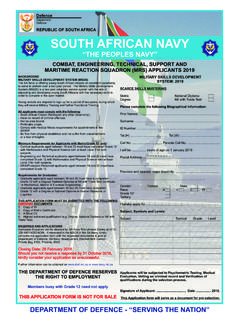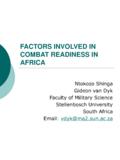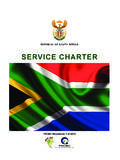Transcription of FAACCTT SSHHEEEETT - UNICEF
1 FFFAAACCCTTT SSSHHHEEEEEETTT CHILDREN ASSOCIATED WITH ARMED G OUPS AND FORCES RCENTRAL africa It is estimated that some 250,000 children, boys and girls under the age of 18, are today involved in more than 30 conflicts worldwide. Thousands of children have been recruited in the Central African region (Chad, Central African republic and Sudan). Reasons For Recruitment Some children are abducted or forcibly recruited; others are driven to join by poverty, abuse and discrimination or to seek venge for violence against them or their families. Children are more likely to become child soldiers if they are separated from their families, displaced from their homes, living in conflict areas re with limited access to education and are vulnerable to recruitment by armed forces and groups.
2 Children may voluntarily take part in warfare, not realizing the dangers and abuses they may be subjected to. While mainly boys are recruited, girls may also be caught up by armed forces and groups where they face a significant risk of sexual exploitation. The breakdown of governments during conflict makes it very difficult to identify and influence those recruiting and using children for combatant and non combatant roles. The Optional Protocol to the Convention on the Rights of the Child on the Involvement of Children in Armed Conflict (OPAC): Anyone under the age of 18 cannot be used in conflicts or recruited into armed groups. Governments may accept volunteers from the age of 16, but they cannot compulsorily recruit anyone under 18.
3 The Optional Protocol came into force in February 2002 and has been ratified by 132 Member States. Over 80 States Parties have deposited declarations prohibiting recruitment below the age of 18. The Paris Commitments to protect children from unlawful recruitment or use by armed forces or armed groups, adopted in February 2007, further strengthen the child protection framework that ensures accountability and the global fight against impunity for crimes against children; they have been officially endorsed by 84 Member States. The International Criminal Court in The Hague can prosecute non-government armed groups who recruit children under 15 years old. Chad and Sudan have signed and ratified the Optional Protocol to the Convention on the Rights of the Child (CRC) on the Involvement of Children in Armed Conflict.
4 Cameroon and Nigeria have signed, but have not yet ratified. CAR and Niger have neither signed nor ratified. For the purposes of disarmament, demobilization and reintegration programmes, UNICEF defines a child soldier as any child, boy or girl, under the age of 18, who is part of any kind of regular or irregular armed force or armed group in any capacity. This includes, but is not limited to, cooks, porters and messengers. It includes girls and boys recruited for forced sexual purposes and/or forced marriage. The definition, therefore, does not only refer to a child who is carrying, or has carried, weapons. (Based on the Cape Town Principles , 1997).
5 RRREEEPPPUUUBBBLLLIIICCC OOOFFF CCCHHHAAADDD Chad is one of the poorest countries in africa with more than half of the population living on less than one dollar a day. Landlocked between the Libyan Arab Jamahiriya to the north, Sudan to the east, the Central African republic to the south, and Cameroon, Nigeria and Niger to the west, it was ranked at 173 out of 177 countries on UNDP s Human Development Index in 2008. The country has a population of 10,154,300 inhabitants growing at the rate of per cent per year. More than half of the population is 15 years old or less. Chad has faced instability nationally and regionally over the past few decades. This led to a series of armed conflicts in the east of the country and the capital, N'Djamena. There has also been a spillover from the conflict in neighbouring Sudan.
6 Consequently, there have been serious violations of children's rights with recruitment of children and use of them by armed groups and forces. According to Chad's Ministry of Defence 7 to 9 percent of those released from rebel groups in 2009 were minors. Over 800 children have been demobilized since 2007. Reports indicate that children were recruited not only by rebel groups and Chadian forces, but also by the Sudanese armed groups, including the Janjaweed, the Movement for Justice and Equality Movement (JEM), and l 'Liberation Army of Sudan. Statistics of demobilisation of children since 2007 also reveals that the Chadian armed forces have recruited minors (4,4% have been demobilised). The Arm e nationale tchadienne (ANT), the Ministry of Defense sent out orders to commanders of armed and security forces to grant access to military camps to UNICEF , and the International Committee for the Red Cross for monitoring and verification.
7 The Government also initiated and allowed joint verification visits by the UN agencies to military barracks and training centres in Ab ch (eastern Chad), Moussoro in western Chad, Mongo and Koundoul in central Chad UNICEF Chad/2010/Sweeting Children have been released from the following armed groups: Front pour le Salut de la R publique (FSR); Front uni pour le changement (FUC); Mouvement national pour le redressement (MNR); Rassemblement des forces pour le changement (RFC);Conseil d mocratique et r volutionnaire (CDR); Union des forces r volutionnaires (UFR); Union des forces pour la d mocratie et le d veloppement (UFDD); Union des forces d mocratiques pour le changement (UFCD); Union des forces d mocratiques (UFD); Front populaire pour la renaissance nationale (FPRN); and Union pour le changement d mocratique (UDC) These actions were taken following a cooperation agreement signed between UNICEF and the Chadian Government in May 2007 for the development and implementation of activities aimed at preventing recruitment, withdrawal and reintegration of all children associated with armed forces and armed groups in Chad.
8 UNICEF Chad activities related to rehabilitation and reinsertion of former child soldiers has been funded by: Government of France, Government of USA, Government of Spain, Government of Japan, Government of United Arab Emirates, CIDA- Canada, UN CERF Fund, UNICEF French and USA National Committees, ECHO. UNICEF Chad In Action Support to the Ministry of Social Action for the withdrawal process, transitional care and rehabilitation of children withdrawn from armed forces and groups and develop mechanisms for border monitoring. Participation in joint missions with the Government to verify the presence of children in military sites of the Chadian National Army (ANT); Co-chairing with MINURCAT Task Force for Monitoring and Reporting Mechanism on grave violations of child rights in accordance with Resolution 1612 of UN Security Council.
9 Capacity building of military on child rights and support for the process of identification of minors. Support to the Ministry of Social Action for the process of withdrawal and sustainable reintegration of children from armed forces and groups and developing mechanisms for monitoring the eastern border with Sudan. In order to strengthen mechanisms to deal with cross border recruitment UNICEF Chad and the Government of Chad jointly organizes the regional conference with Sudan, CAR, Cameroon, Nigeria and Niger: Ending Recruitment and Use of Children in Armed Forces and Groups: Contributing to Peace, Stability and Development . RRREEEPPPUUUBBBLLLIIICCC OOOFFF SSSUUUDDDAAANNN Sudan s recent history since independence in 1956 has been marred by conflict.
10 africa s longest civil war, between the north and south Sudan, spanned five decades although there was a period of relative peace in the 1970s. During the last 20 years of the conflict at least two million died and millions more were displaced. The conflict finally ended in 2005 with the signing of the Comprehensive Peace Agreement. Thousands of children were caught up in the north-south war. In recent years there have also been armed uprisings in the east of Sudan and there s the ongoing conflict in the western region of Darfur which started in 2003. There have been serious violations of children s rights with the recruitment of children by the rebel movements and armed forces. 6,500 children associated with armed groups/forces in North Sudan including some 4,500 children in Darfur.

















